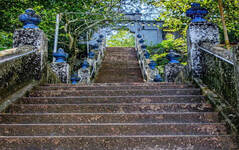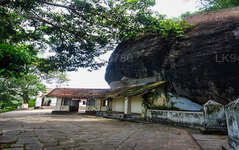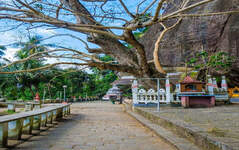
Tangalle City
Strung out along one of the South's most stunning stretches of coastline, TANGALLE (or Tangalla) is among the region’s more developed beach destinations, with a string of simple guesthouses – and a handful of upmarket hotels and villas – dotted along the coves and beaches which line the oceanfront here.
Mulkirigala Raja Maha Vihara
Among the known ancient rock temples of Sri Lanka Mulkirigala Raja Maha Vihara (Mulkirigala Great Royal Temple) comes close behind Sigiriya in architecture and style. While not as famous as the Lion Rock this temple is even more ancient by almost a couple of centuries. Today this temple has been recognized as an archaeological site by the government, and is a marvel of architecture, paintings and sculptures.
Location
Mulkirigala is about 2 km (1.2 miles) from the Mulkirigala junction and is reachable from either the Dikwella or Tangalle towns. The temple itself is embedded into a giant 205 m (673 ft) tall rock and surrounded by four other rocks called Benagala, Kondagala, Bisogala and Seelawathiegala.The site is known as ‘Punchi Seegiriya’ or Little Sigiriya.
History
Also referred to as Mulgirigala, Muvathitigala, Muhudungiri and Dakkhina Vihara in the current world Mulkirigala has been identified to be the temple known as Giriba Vihara in the ancient religious chronicle Bodhi Vamsa. Through this it has now been know that Mulkirigala is a temple where one of the 32 seedlings germinated from the original Jaya Sri Maha Bodhi (the holy bo tree branch that was brought by Sangamitta and planted in Sri Lanka, when she introduced Buddhism to the country) was planted.
Mahavamsa, another religious chronicle states that the Mulkirigala Temple was built in the 3rd century AD by the King Saddhatissa. The temple continued to receive royal patronage and was renovated by many of the following kings. During the 461-479 AD time period a stupa was added to the temple by King Datusena; and it was further developed by King Kirti Sri Rajasinghe who reigned during the mid 18th century. During the 18th century, under the reign of the Dutch, the Mulkirigala rock attained fame as ‘Adam’s Berg’. The Dutch believed that tombs of Adam and Eve were located here.
Structure
The site comprises of seven smaller temples and has been constructed within five areas; the Siyambalamaluwa, the Lower Temple Compound, Bomaluwa, the Royal Temple Compound, and the Upper Temple Compound. There are also caves with figurines and murals within them
Siyambalamaluwa
This area comprises of the museum, lower temple and the rest house.
Lower Vihara compound
This includes of the Royal Temple, Tombs, Seemamalakaya, Monastery and Paduma Rahath temple. Paduma Rahath Vihara contains the largest reclining Buddha image of the entire temple. There is also a small painted pagoda found inside a cave and a modern information centre built on a terrace.
Bomaluwa
The Bomaluwa is an area with the Vesak hall compound, the Majjhima Nikaya cave (Bhanaka cave), the Viharagal rock inscription (between 1400 – 1500 years old), and the Bomaluwa (Bo tree Terrace).
The Great Royal Temple Compound
This contains the Piriniwan Manchakaya, the Royal Great Temple, the new temple, Naga temple, pond, rock inscription (12th century), a lamp postand Diyagoda Etha Temple. The rock inscription found in this compound reveals the ancient name of the temple as Muhundgiri Temple
The Upper Temple Compound
Dethispala bo tree, attendant bo tree, Garandi Kapolla, stupa, bell tower, pond and horizon valley can be seen in upper vihara compound. Dethispala bo tree is believed to the original sapling from the Jaya Sri Great Bo tree.
The Paintings
A large collection of murals and sculptures belonging to the Kandyan Era can be seen in the caves, and image houses in the temple premises. Most paintings depict the episodes from the life of the Gautama Buddha and Jataka stories, such as Vessantara, Telapatta and Shivi.
Mulkirigala Great Royal Temple is fast becoming one of the most important attractions of
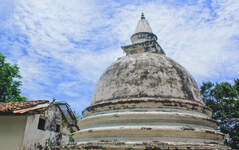
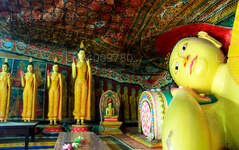
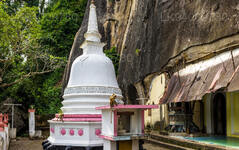
About Hambantota District
Hambantota is a rural town in southeastern coastal area of Sri Lanka. It is also the capital of the Hambantota District in the Southern Province of Sri Lanka. Approximately 240 kms from Colombo, Hambantota is in the midst of transformation into a strategic port and commercial centre, undergoing extensive infrastructure development. Flanked by sweeping sandy beaches, Hambantota is a convenient location from which to visit nearby sights.
The Bundala National Park lays 20 km east of Hambantota and the Weerawila Sanctuary a little further off. The Ruhuna National Park and the Kataragama Temple are other attractions that can be accessed easily from this city.
About Southern Province
The Southern Province of Sri Lanka is a small geographic area consisting of the districts of Galle, Matara and Hambantota. Subsistence farming and fishing is the main source of income for the vast majority of the people of this region.
Important landmarks of the Southern Province include the wildlife sanctuaries of the Yala and Udawalawe National Parks, the holy city of Kataragama, and the ancient cities of Tissamaharama, Kirinda and Galle. (Although Galle is an ancient city, almost nothing survives from before the Portuguese invasion.) During the Portuguese period there were two famous Sinhalese poets called Andare who was from Dickwella and Gajaman Nona who was from Denipitiya in Matara District, composing poems on common man.

